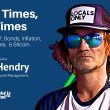by Hubert Marleau, Market Economist, Palos Management
July 7, 2023
What is regrettable about the financial markets is that many widely known personalities who make predictions about the outlook for the economy often fail to back-up their claims with valid theories or support them with empirical evidence. This observation is aimed especially at the perma-bear, but it’s also applicable to others. If one is not ready to offer plausible rationales to justify assertions, they shouldn't be taken seriously.
The labour market needs to loosen up some more to appease the Fed, though a metric constructed by LinkedIn shows that it is in fact cooling. In May, there were 0.6 job openings for all active applications on its site - a notable cooldown from the most recent peak of 1 job opening for all applicants seen in the final months of 2022.
The shortened holiday week gave a barrage of official economic prints, which validated the aforementioned proposition that a larger pool of workers is angling for fewer job opportunities.
First, the ISM manufacturing index for June shows that manufacturers are reducing headcount. The employment component dropped from 51.4 to 48.1.
Second, the surge in Americans voluntarily quitting their jobs has abated. The quit ratio - the number of departures as a share of total employment - fell this spring to 2.4%, matching pre/pandemic readings and down from 3% a year ago.
Third, ADP reported that private sector employers added 497,000 new jobs in June, spread across small and mid-sized firms in mining, construction, leisure and hospitality, with signs of moderation in pay growth - a blockbuster beat suggesting that there is zip in the economy. The size of this number, however, is questionable because its methodology was comprehensively rebuilt last summer. With only 10 new observations, and many past errors, I have no way of knowing if one should completely rely on the print, and suspect that it's a catch-up. Incidentally, Initial Jobless Claims, which measures the number of individuals who filed for unemployment insurance for the first time in the past week, rose to 248k from 236k in the previous week. Employers announced 40,709 cuts in June. The Challenger, Gray & Christmas counted 458,209 announced cuts for the first half of 2023, up 244% from the period a year ago - on track for the most job cuts outside of COVID and the financial crisis.
Fourth, the ISM Services Employment increased to 53.1 in June from 49.2 in May, the only sector that is still employing more people.
Fifth, the number of job openings decreased by about 500k in May to 9.8 million, taking them to the March level and bringing the number of unemployed persons per job opening to 0.6. As a matter of fact, NFIB hiring intentions have weakened.
Last, the Bureau of Labor announced on Friday that the economy had added 209,000 workers in June and revised down by 77,000 the job gains in May, underwhelming the flaming-hot ADP report. The unemployment rate fell to 3.6% while the participation rate held steady at 62.5%.
All told, labour demand is cooling and trending down, but the deep job losses predicted due to inflation and interest rates may not come to pass. Right now, the numbers are saying that the tightening of monetary policy is gradually eating up job openings without a sharp increase in the unemployment rate or a serious decline in job creations. The Fed, meanwhile, is counting on job openings to fall because the viability of a soft landing depends on it. In theory, vacancies can recede with slower demand, and with fewer infilled openings, the labour market will balance and wage growth will normalise, defusing the threat of a wage-price spiral.
At the Federal Reserve meeting, staff economists predicted a mild recession later this year, but insisted that avoiding one was just as likely. Interestingly, FT readers of Robert Armstrong’s unhedged article have become less concerned about recession. Respondents to his survey put the chances of one at 55%, down from 65% with 45% betting on avoidance. Ed Yardeni sees a 75% chance of a soft landing. Thus the idea that price stability can be restored without a deep recession is plausible.
The “Truflation” measure of U.S. inflation, which is updated daily, based on 10 million data points, was 2.21 on Thursday last. Andrew Lees of Macro Strategy Partnership pointed out: “The average of the 1st and last day of May was 3.4%, 60 bps below the official 4% CPI print which uses only 80,000 data points. The average of the 1st and last day of June was 2.62%, which applying the same 60 bps difference would imply June CPI would be 3.2%.” Assuming the Truflation measure continues to decline at a similar pace, it is likely to be below 2% by the end of this month, inferring July CPI around 2.7%. Incidentally, new data from the New York Federal Reserve shows underlying inflation may have slowed faster than the underlying measures. Meanwhile, the Atlanta Fed Now model estimate for real GDP growth in the second quarter of 2023 is 1.9%. That would look like the pre-pandemic 2-plus-2 economy - 2% for inflation and 2% for growth. In other words, a soft landing immaculate disinflation narrative is not out of the question.
It may be too early to celebrate a final victory over inflation, but a significant amelioration in the Misery Index has occurred with prospective improvement. This index is the simple addition of the unemployment rate (3.6%) to inflation (4.1%). Presently, it stands at 7.7%. Should consumer inflation show a 3.2% year-over-year increase for June, as I expect, the index would fall to 6.7%, with an inflationary content of 48% - not the Fed's desired optimal level, but getting close.
Based on my readings on this subject matter, an ideal number would be 6.25 points, with an inflation content of 32%. That is 2% for inflation and 4.25% for the unemployment rate. I would bet on this one. The University of Michigan Sentiment and Conference Board Confidence surveys are of the bottom, indicating that public opinion is on an upward trajectory.
I also believe that the bond market is communicating that the Fed will be victorious in the end with a clean win. This conviction is based on two observations. Break-even inflation rates have been moving sideways for 2 years around 2.25%, suggesting that inflation will soon return to target. Meanwhile, real rates have moved up through the piece, implying that real growth is what is sticky. Incidentally, that is what a soft landing is: falling inflation and a steady unemployment rate.
Tom Lee, an enduring bull at Fundstrat, lifted his year end forecast for the S&P 500 to 4825 - 10% higher than Friday’s close (4399). He pins his prediction on assurance that AI advancements will shake the market and confidence that the Fed will be successful in curbing inflation. Soon, the hawks of Fed will capitulate because data trends will overtake them.
Copyright © Palos Management
















